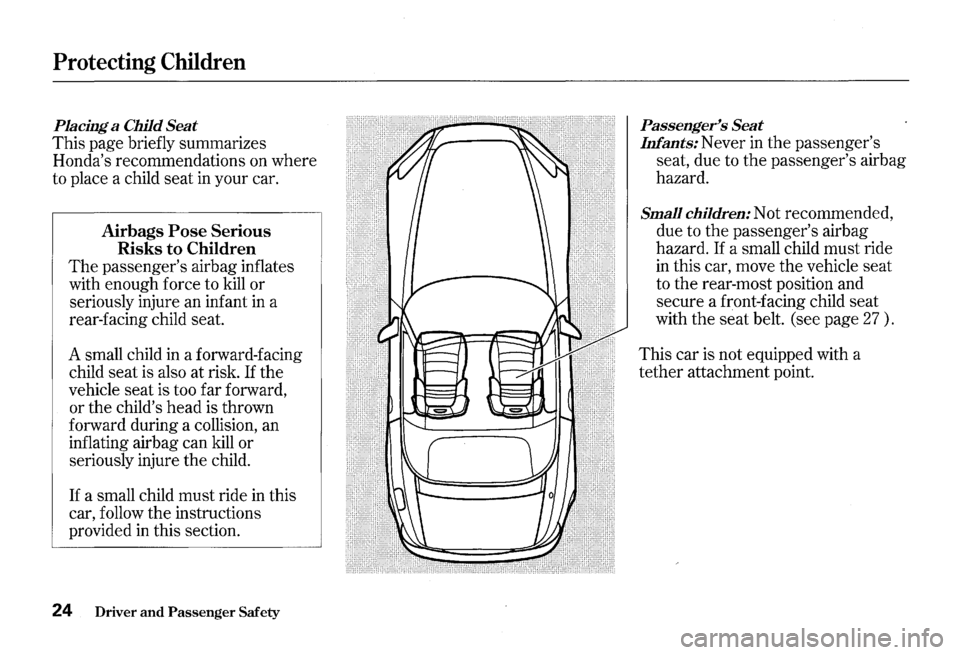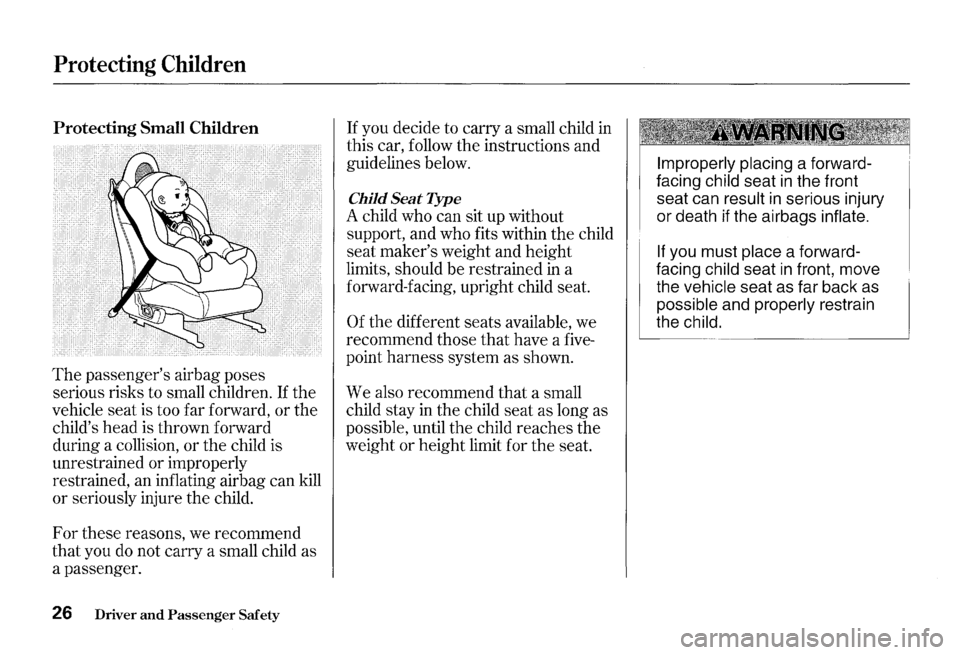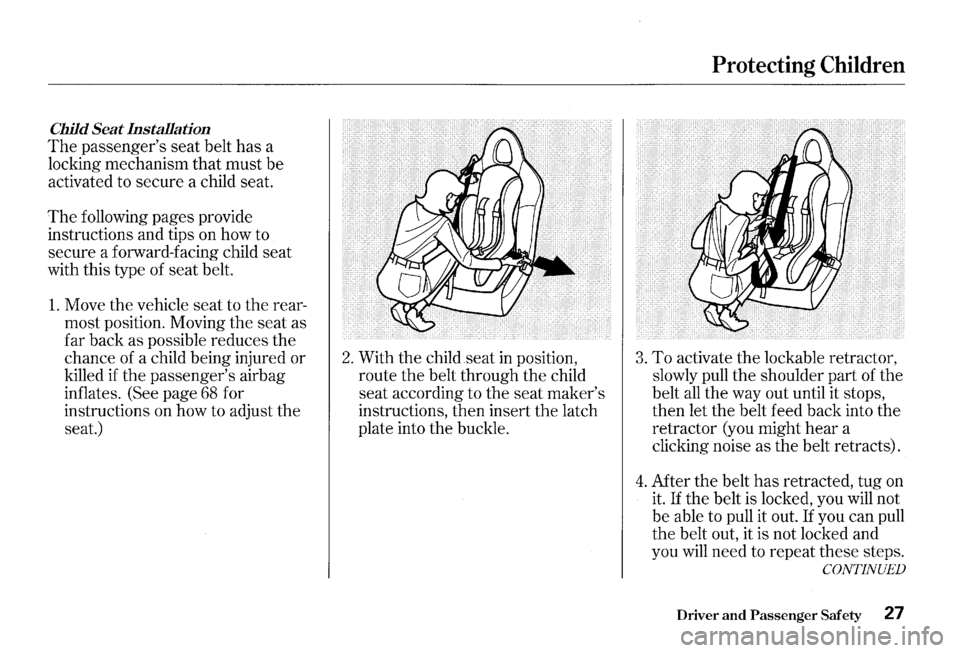Page 20 of 273
Advice for Pregnant Women Because protecting the mother is the
best way to protect
her unborn child,
a pregnant woman should always
wear a seat belt whenever she drives
or rides
in a vehicle.
Remember to keep the lap portion of
the belt as
low as possible across
your hips.
Protecting Adults
Pregnant women should also sit
upright and as far back as possible
from the steering wheel or
dashboard. This
will reduce the risk
of injuries to both the mother and
her unborn child that can be caused
by a crash or an inflating airbag.
Each time you have a check-up, ask
your doctor
if it's okay for you to
drive.
Driver and Passenger Safety 17
Page 21 of 273

Protecting Adults
Additional Safety Precautions
• Two people should never use the
same seat belt. If they do, they
could be very seriously injured in a
crash.
• Do not put any accessories on seat
belts. Devices intended to improve
occupant comfort or reposition
the
shoulder part of a seat belt can
severely compromise the
protective capability of the seat
belt and increase the chance of
serious injury in a crash.
18 Driver and Passenger Safety
• Do not place hard or sharp objects
between yourself and an airbag.
Carrying hard or sharp objects on
your lap, or driving with a pipe or
other sharp object
in your mouth,
can result
in injuries if your
airbags inflate.
• Keep your hands and arms away
from the airbag covers. If your
hands or arms are close to the
SRS
covers in the center of the
steering wheel and on top of the
dashboard, they could be injured
if
the airbags inflate.
• Do not attach or place objects on
the airbag covers. Any object
attached to or placed on the
covers marked
"SRS AIRBAG,"
in the center of the steering
wheel and on top of
the
dashboard, could interfere with
the proper operation of the
airbags.
Or, if the airbags inflate,
the objects could be propelled
inside the car and
hurt someone.
Page 23 of 273

Protecting Children
Your Car is Not Recommended
for Child Passengers
We strongly recommend that you do
not carry any child in this car.
One reason is that your car does not
have a back seat, and accident
statistics show that a child of any
size or age is safer when they are
properly restrained
in the back seat
of a vehicle.
In addition, your car
has a passenger's
air bag which poses serious risks to
children-particularly infants and
small children.
20 Driver and Passenger Safety
The Passenger's Airbag Poses
Serious Risks to Children
Airbags have been designed to help
protect adults
in a moderate to
severe frontal collision. To
do this,
the passenger's airbag is quite large,
and it inflates with tremendous
speed.
As a result, we urge you to follow
these guidelines.
Infants
Never put a rear-facing child seat in
the front seat of a car equipped with
a
passenger's airbag. If the air bag
inflates, it can hit the back of the
child seat with enough force to kill or
very seriously injure an infant.
Small Children
Placing a
f01ward-facing child seat in
the front seat of a car equipped with
a
passenger's airbag can be
hazardous. If the vehicle seat is too
far forward, or the child's head is
thrown forward during a collision, an
inflating airbag can strike the child
with enough force to kill or very
seriously injure a small child.
If a
small child must ride
in this car,
follow the instructions on page
23 .
Larger Children
Children who
have outgrown child
seats are also at risk of being injured
or killed by an inflating passenger's
airbag. If a larger child must ride in
this car, see page 29 for important
guidelines on how to decide whether
a child is large enough and mature
enough to ride as a passenger, and
how to properly protect the child.
Page 24 of 273

U.S. Models
To remind you of the passenger's
airbag hazards, your car
has warning
labels on the dashboard and on the
driver's and passenger's visors.
Please read and follow the
instructions on these labels.
A WARNING
®
DEATH or SERIOUS INJURY can occur • Children 12 and under can be krlled by the rur bag • NEVER pula rear-facrng chrld seat rn lhe front • Sri as far back as possrble !rom !he arr bag • ALWAYS use SEAT BELTS and CHILD RESTRAINTS
A WARNING
Children Can Be KILLED or INJURED
by Passenger Air Bag
MaKe sure all cnildren use sea! bells or cnild seals.
Canadian Models
To remind you of the airbag hazards,
your car has warning labels on the
driver's and passenger's visors.
Please read and follow
the
instructions on these labels.
CAUTION TO AVOID SERIOUS INJURY: • FOR MAXIMUM SAFETY PROTECTION IN ALL TYPES OF CRASHES, YOU MUST
ALWAYS WEAR YOUR SAFETY BELT. • DO NOT INSTALL REARWARD-FACING CHILD SEATS IN ANY FRONT
PASSENGER SEAT POSITION.
•
DO NOT SIT OR LEAN UNNECESSARILY
CLOSE TO THE AIR BAG. • DO NOT PLACE ANY OBJECTS OVER THE AIR BAG OR BETWEEN THE AIR BAG
AND YOURSELF.
• SEE THE OWNER'S MANUAL FOR FURTHER INFORMATION AND EXPLANATIONS.
Protecting Children
PRECAUTIONS:
POUR EVITER DES BLESSURES GRAVES:
• POUR PROFITER D'UNE PROTECTIOON
~~3j~t~Es ~cffR~· ~NEE?N~LQ-~~~~ ~~~~~T~E. • NINSTALLEZ JAMAIS UN SIEGE POUR ENFANTS FAISANT FACE A L'ARRIERE SUR LE SIEGE DU PASSAGER AVANT.
• NE VOUS APPUYEZ PAS ET NE VOUS ASSOYEZ
PAS PRES DU COUSSIN GONFLABLE. • NE DEPOSEZ AUCUN OBJET SUR LE COUSSIN GONFLABLE OU ENTRE LE COUSSIN GONFLABLE ET VOUS. e LISEZ LE GUIDE UTILISATEUR POUR DE PLUS AMPLES RENSEIGNEMENTS.
Driver and Passenger Safety 21
Page 25 of 273

Protecting Children
Additional Safety Precaution
• Do not leave a child alone in your
car. Leaving a child without adult
supervision is illegal
in most states
and Canadian provinces and can
be very hazardous. For example, a
small child left
in a car on a hot
day can die from heatstroke. A
child left alone with the key in the
ignition can accidentally set the
car
in motion, possibly injuring
themselves
or others.
22 Driver and Passenger Safety
General Guidelines for Using
Child
Seats
As discussed on page 20, because
your car does not have a back seat,
and because
of the passenger's
airbag hazard, we strongly
recommend that you
do not carry a
small child as a passenger
in this car.
However,
if you must carry a small
child
in this car, the child must be
properly restrained in a child seat.
The following pages give general
guidelines for selecting and installing
a child seat.
See page 26 for
additional information.
Selecting a Child Seat
To provide proper protection, a child
seat should meet three
requirements:
1. The child seat should meet safety
standards. The child seat should
meet Federal Motor Vehicle
Safety Standard
213 (FMVSS 213)
or Canadian Motor Vehicle Safety
Standard
213 (CMVSS 213). Look
for the manufacturer's statement
of compliance on the box and seat.
Page 27 of 273

Protecting Children
Placing a Child Seat
This page briefly summarizes
Honda's recommendations on where
to place a child seat in your car.
Airbags Pose Serious
Risks to Children
The passenger's airbag inflates
with enough force to kill or
seriously injure an infant in a
rear-facing child seat.
A small child
in a forward-facing
child seat is also at risk.
If the
vehicle seat is too far forward,
or the child's head is thrown
forward during a collision, an
inflating airbag can kill or
seriously injure the child.
If a small child must ride in this
car, follow the instructions
provided in this section.
24 Driver and Passenger Safety
Passenger's Seat
Infants: Never in the passenger's
seat, due to
the passenger's airbag
hazard.
Small children: Not recommended,
due to
the passenger's airbag
hazard.
If a small child must ride
in this car, move the vehicle seat
to the rear-most position and
secure a front-facing child seat
with
the seat belt. (see page 27).
This car is not equipped with a
tether attachment point.
Page 29 of 273

Protecting Children
Protecting Small Children
The passenger's airbag poses
serious risks to small children.
If the
vehicle seat is too far forward, or the
child's head is thrown forward
during a collision, or
the child is
unrestrained or improperly
restrained, an inflating airbag can kill
or seriously injure the child.
For these reasons, we recommend
that you
do not carry a small child as
a passenger.
26 Driver and Passenger Safety
If you decide to carry a small child in
this car, follow the instructions and
guidelines below.
Child Seat Type
A child who can sit up without
support, and who fits within the child
seat maker's weight and height
limits, should be restrained
in a
forward-facing, upright child seat.
Of the different seats available, we
recommend those
that have a five
point harness system as shown.
We also recommend that a small
child stay
in the child seat as long as
possible, until the child reaches the
weight or height limit for the seat.
Improperly placing a forward
facing
child seat in the front
seat can
result in serious injury
or death if the airbags
inflate.
If you must place a forward
facing
child seat in front, move
the
vehicle seat as far back as
possible and properly restrain
the
child.
Page 30 of 273

Child Seat Installation
The passenger's seat belt has a
locking mechanism that must be
activated to secure a child seat.
The following pages provide
instructions and tips on how to
secure a forward-facing child seat
with this type of seat belt.
1. Move the vehicle seat to the rear
most position. Moving the seat as
far back as possible reduces the
chance of a child being injured or
killed
if the passenger's airbag
inflates. (See page
68 for
instructions on how to adjust the
seat.)
2. With the child seat in position,
route the belt through the child
seat according to the seat maker's
instructions, then insert the latch
plate into the buckle.
Protecting Children
3. To activate the lockable retractor,
slowly pull the shoulder part
of the
belt
all the way out until it stops,
then let the belt feed back into the
retractor (you might hear a
clicking noise as the belt retracts).
4. After the belt has retracted, tug on
it. If the belt is locked, you will not
be able to pull it out.
If you can pull
the belt out, it is not locked and
you
will need to repeat these steps.
CONTINUED
Driver and Passenger Safety 27